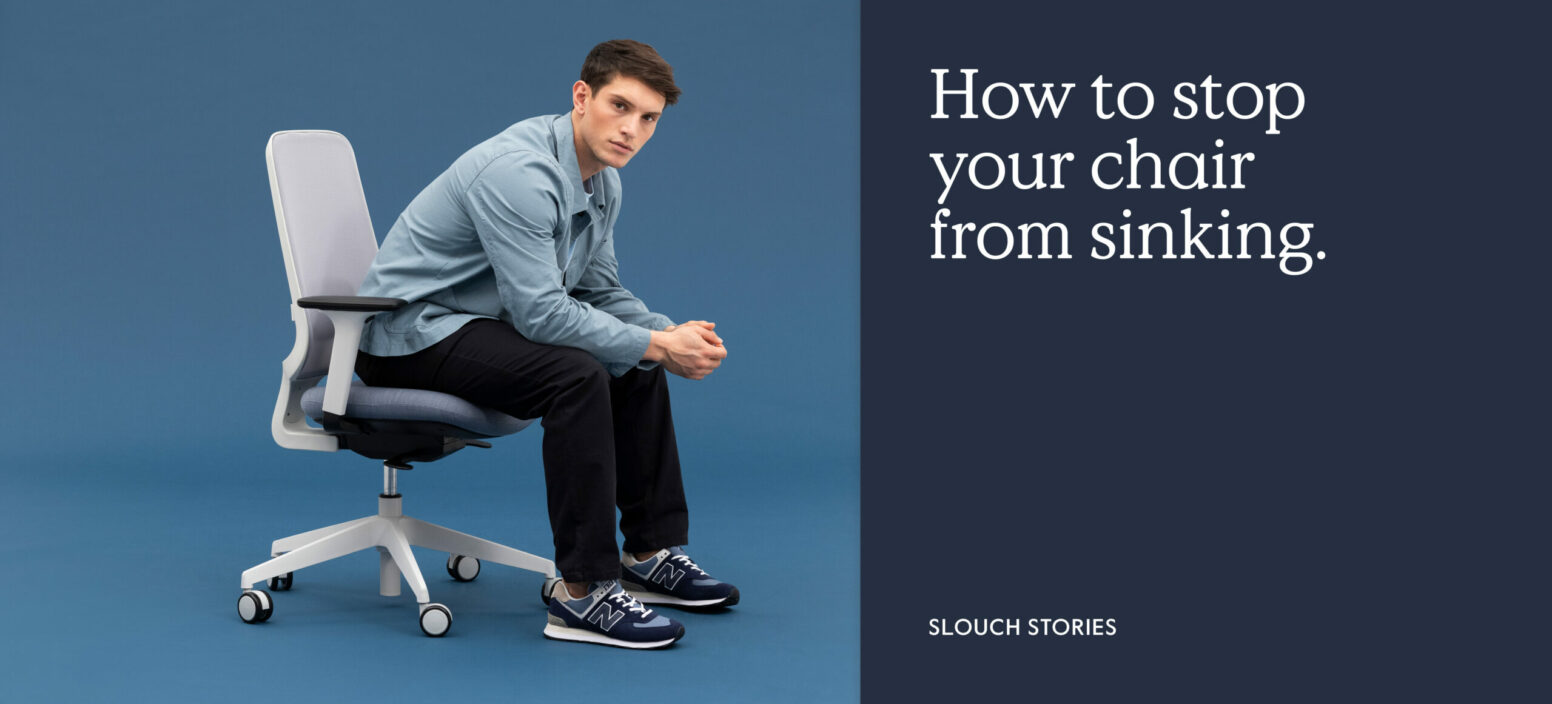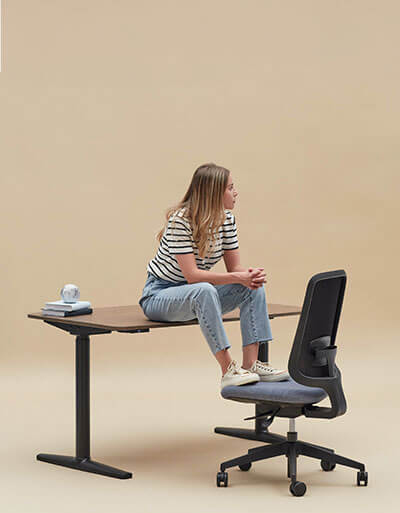If your office chair keeps sinking, there are a few tried and tested hacks you can use for a DIY fix. However, if the time is right for a new ergonomic upgrade, our home office chairs are the best it gets. You’ll be able to sit back and relax while you work, knowing your new replacement fully supports your body. Just some food for thought…
Let’s run you through the tricks you can try to get your office chair to stay where it’s put!
So why does your office chair keep sinking?
Keep scrolling if you just want the solutions, but it might help you to understand what’s going wrong to make your chair sink, so you can fix it. 9 times out of 10, the issue is with the pneumatic cylinder, aka the metal tube that connects your seat to the wheelbase.
Why pneumatic chairs start sinking
Pneumatic chairs use compressed air to help you easily adjust your seat height with a pump of a lever. That’s the mechanics behind what raises you up.
When you release the lever, a seal engages to keep the air pressure stable, holding your chair at the desired height.
Over time, this seal can wear out, gradually letting air escape. Less air means less pressure, so less support. And often, that’s why your office chair keeps going down.
What can affect the seal?
- Regular wear and tear over time
- Excessive weight beyond the chair’s capacity
- Abrupt movements like dropping heavily into the seat
- Manufacturing defects in the cylinder
- Dust and debris interfering with the mechanism
Whether you have a chair that slowly sinks throughout the day or it drops immediately when you sit on it, the pneumatic cylinder likely needs attention. If your chair has a warranty, we’d suggest you get in touch with the manufacturer to repair or replace it for you. However, if that’s not an option, you might want to take a look at the DIY options that we’ll cover next.
DIY fixes for an office chair that keeps sinking
The good news is that there are several DIY methods that might solve the problem, at least temporarily. They are…
The PVC pipe method
This is one of the most popular fixes for a sinking office chair, as it’s relatively simple and provides a stable solution.
What you’ll need:
- PVC pipe (diameter slightly larger than your chair cylinder)
- Hacksaw
- Measuring tape
- Screwdriver (for disassembly)
Steps:
- Set your chair at your ideal height (you might need someone to help hold it in place as an extra pair of hands).
- Turn the chair upside-down and remove the wheelbase to expose the cylinder.
- Measure the exposed part of the cylinder that extends from the chair mechanism.
- Cut a piece of PVC pipe to this exact length.
- Create a lengthwise cut along the PVC pipe so you can wrap it around the cylinder.
- Snap the pipe around the cylinder, positioning it to support the chair at your desired height.
- Reattach the base and wheels.
When you add in the piece of PVC piping, you’re effectively creating a physical barrier that prevents the cylinder from compressing further. You should have a stable, static chair that doesn’t sink. However, it also means you can no longer adjust the chair height.
The hose clamp method
If you’re looking for a less bulky solution, a hose clamp can do the trick.
What you’ll need:
- Adjustable hose clamp (about 2cm wide)
- Screwdriver
- Duct tape or sandpaper
- WD-40 or similar lubricant (optional)
Steps:
- Set your chair to your preferred height.
- Clean the metal cylinder thoroughly.
- Add some grip to the cylinder by either wrapping duct tape around it or scuffing it lightly with sandpaper.
- Wrap the hose clamp around the cylinder just beneath the chair mechanism.
- Tighten the clamp firmly using a screwdriver until it’s secure against the cylinder.
Just like the PVC piping, the clamp creates a physical barrier that prevents the cylinder from sliding downward, keeping your chair at the right height but without the eyesore of the piping.
Replace the gas cylinder
If your chair is still in decent nick overall, swapping out just the pneumatic cylinder can be a more permanent solution. However, it’s a much more involved process. You’ll need to acquire a new cylinder – either as a replacement part from the original manufacturer or an alternative that fits your chair.
We’d also recommend investing in a cylinder removal tool or hammer and a pipe wrench to get the old cylinder out. This part of the process can be especially challenging, depending on how stubborn the old cylinder is to remove from the wheelbase. Take a look at the video below to get an idea of what the removal process involves.
Once it’s out, you’ll need to carefully replace it by screwing it into the empty cavity.
Need instant help? Use these fixes
If you need a solution ASAP while you wait for parts or a new chair, you can try implementing these temporary fixes with materials you’re likely to have around the house:
- Cling film: Tightly wrap several layers of cling film around the cylinder, creating enough friction to slow the sinking.
- Duct tape: If cling film isn’t quite doing the trick, you can add the stickiness by trying duct tape. Wrap it all the way around and below the cylinder.
- Cable ties: Again, this is something you might already have on hand that you can try tying around the cylinder for immediate temporary support.
How to extend your chair’s lifespan
If you’ve taken the time to find out how to fix an office chair that keeps going down, you probably don’t want to have to deal with it again. Keep your chair stable for as long as possible with these handy tips:
- DO regularly clean the cylinder to remove dust and debris
- DON’T drop heavily into your chair or lean back with sudden force
- DO use a chair mat to reduce strain on the base and help the chair move more smoothly. This is also a great way to protect carpet from office chair wheels!
- DON’T exceed the chair’s recommended weight capacity, as this will put extra strain on the mechanics
- DO make any adjustments carefully rather than yanking on the handle, which will accelerate wear and damage
You might be surprised at how much making a habit of these rules can extend your chair’s lifespan!
Time for a new chair? It’s got to be Slouch
Sometimes, even the best DIY fixes can only get you so far. If your chair is older, showing multiple signs of wear, or if you’ve already replaced the cylinder without success, it might be time to invest in a quality replacement.
At Slouch, we’ve designed our ergonomic chairs with longevity in mind. We understand the frustration of furniture that doesn’t last, which is why we construct chairs with quality materials and components. Plus, the ergonomic design reduces strain on the mechanisms because you’re exactly where you need to be once you’ve set it up.
Having issues with your Slouch chair? We give you all the support you need to get it sorted, simply. From day one of receiving your new office chair, you’ll have access to clear assembly and set up guides. And in the unlikely event that you’re having an issue with your chair sinking, we have a hassle-free return and replacement policy.
If you have any questions about our chairs or need advice on your specific situation, our friendly team is ready to help at [email protected]

